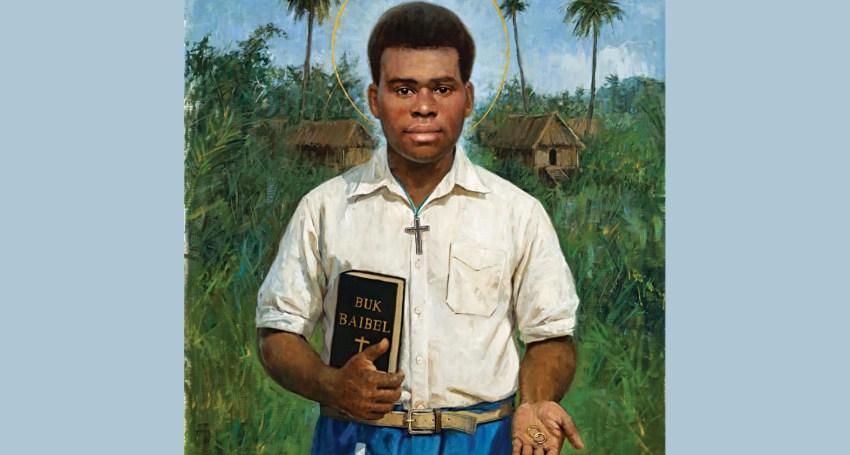Saint for Oceania
Opinion
On Sunday October 19 the Catholic Church will celebrate a moment of profound significance: the canonisation of Peter To Rot from Papua New Guinea.

For Australian Catholics, this occasion is not only a recognition of a holy life lived faithfully, but also an invitation for us to see more fully the breadth and beauty of the Catholic story, one that stretches far beyond familiar European roots and into the heart of Oceania.
Peter To Rot was a lay catechist, husband, father and martyr. Born in 1912 in Rakunai, New Pomerania, (New Britain), he grew up in a family deeply committed to the Catholic faith. His father was among the first local chiefs to welcome Christian missionaries, and Peter himself took on the work of teaching the faith in his community.
Advertisement
His ministry deepened during the years of Japanese occupation in World War II, when priests were imprisoned and the faithful relied on lay leaders to sustain their spiritual life. Peter stepped into this responsibility with quiet courage.
Peter taught, prayed and encouraged the people to hold fast to Christ even when it was dangerous to do so.
When he refused to compromise on the Church’s teaching about the sanctity of marriage, (criticising Japanese attempts to encourage his people to return to the pre-Christian practice of taking multiple wives), he was imprisoned and killed in 1945. His witness cost him his life, and it sealed his testimony of faith.
For us, his canonisation matters deeply. It is the recognition that sanctity is not confined to distant lands or ancient centuries. Holiness can grow from the soil of our own region, from the same Pacific waters that lap against Australian shores.
In celebrating Peter To Rot, the Church is reminding us that the universal call to holiness truly reaches every corner of the globe, including the islands of our neighbours.
Peter To Rot’s story also broadens the horizons of what it means to belong to the Catholic Church.
Too often, we have inherited a sense of the faith shaped primarily by European traditions – Irish, Italian, Polish, Maltese and others.
These traditions are rich and life-giving, yet, they are not the whole story.
The canonisation of Peter To Rot draws our attention to the fact that Catholicism is not only European; it is also profoundly Oceanian. It is a faith that has taken root in indigenous cultures, island communities and societies that look very different from the ones that first carried the Gospel to Australian shores.
This widening of vision is vital for us today. We live in a time when voices from the margins are being heard more clearly, and some wish to extinguish them.
The canonisation of a Melanesian layman shows that the Catholic story is not a single-thread narrative but a vast tapestry woven from many peoples and cultures.
Hearing the whole Catholic story means listening not only to Rome and Europe but to Papua New Guinea, to Torres Strait, to Timor-Leste, Alice Springs and to the Pacific at large.
Advertisement
In this, we are reminded that the Body of Christ is richly diverse and that the Spirit of God is not bound by any one cultural expression.
Peter To Rot’s canonisation is also a moment of encouragement for lay people. He was not a priest or a bishop; he was an ordinary baptised person whose extraordinary faithfulness sanctified his daily life as a husband, father and catechist. Peter’s life shows that holiness is possible for everyone.
In a Church that sometimes wrestles with questions of lay leadership and participation, his example is both timely and empowering. It says clearly: the Church is nourished not only by ordained ministry but also by the witness of lay men and women who live the Gospel to the full.
Moreover, his story speaks powerfully to the theme of family life. At a time when marriage and family face many pressures, Peter To Rot’s fidelity stands as a beacon.
He defended the sanctity of Christian marriage not in abstract terms, but in the concrete reality of his own life. He cherished his wife and children, and he refused to compromise the faith’s vision of marital love even when it meant persecution.
For us, his canonisation is a reminder that family life, lived faithfully, is itself a path to holiness.
The timing of this canonisation also carries an element of providence.
In the years leading up to 2025, and the Jubilee Year, the Church in Australia has been on a journey of renewal, most notably through the Plenary Council, and locally next year our Diocesan Synod. Questions of identity, mission and future direction have been at the forefront of discussion.
In this context, the canonisation of a neighbouring layman and martyr is a gift.
It tells us that the Spirit is alive and active in our region, raising up witnesses who speak directly to our present challenges. Peter To Rot becomes not only a saint for Papua New Guinea, but also a saint for Australia, for the Pacific and for the whole Church.
It is important, too, to see his canonisation as part of the healing of historical wounds.
The colonisation of the Pacific brought with it both the gift of the Gospel and the scars of cultural disruption.
By honouring Peter To Rot, the Church affirms that holiness has arisen from within these communities themselves, not only through the presence of missionaries from abroad.
It acknowledges that the faith is not foreign to this land, but has been embraced, embodied and even sealed in blood by its own children.
For us as Australian Catholics, this is an invitation to humility and to gratitude. Humility, in recognising that our faith is not the whole story and that our neighbours’ stories are just as vital to the life of the Church. Gratitude, in recognising that our region has given the universal Church a saint, a gift of holiness that enriches us all.
The celebration on October 19 will be more than a ceremony in Rome; it will be a call to renewal here at home. It will be an opportunity to reflect on our shared history with Papua New Guinea, a nation with which we have deep ties of geography, culture and history. It will be a chance to deepen friendships across the Pacific, to see ourselves not as isolated communities but as part of a broader Oceanian Catholic family.
Above all, the canonisation of Peter To Rot calls us to hear the whole Catholic story. Not a story confined to cathedrals in Europe, but one that includes chapels in small villages, catechists teaching under palm trees, families praying together in huts and martyrs giving their lives in hidden corners of the world.
When we open our ears to this fuller story, we discover anew the universality of the Church and the inexhaustible creativity of the Holy Spirit.
On that October day, when Peter To Rot is declared a saint, we will have cause to rejoice. We will rejoice not only for him and his people but for ourselves because his canonisation expands our vision, strengthens our faith and calls us forward into a deeper communion.
His story reminds us that the Catholic Church is indeed a global family, and that our own place within it is enriched when we embrace the whole story.
In Peter To Rot we see courage, fidelity, love of family and steadfast witness. In his canonisation we hear the Holy Spirit speaking anew to our region. And in celebrating him, we open our hearts to the possibility that sanctity is not distant but near, not foreign but familiar, not of the past only but of the present and the future.
This is why his canonisation matters for us as Australian Catholics. It is a sign of hope, a call to unity, and a reminder that the Catholic story is wide enough to hold us all.
It reminds us that God is good, good indeed.








